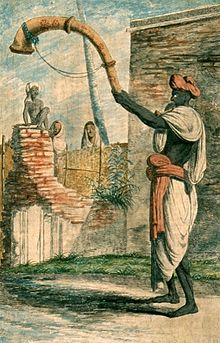Ransingha: Difference between revisions
Undid revision 1010976976 by 103.147.208.165 (talk) User's edit did not work. adding what he wanted after the link |
merged Ramsinga into Ransingha |
||
| Line 2: | Line 2: | ||
[[File:Narsingha, Nepal 1836.jpg|thumb|200px|right|Ransingha, an S-shaped horn.]] |
[[File:Narsingha, Nepal 1836.jpg|thumb|200px|right|Ransingha, an S-shaped horn.]] |
||
The '''ransinga''' |
The '''ransinga''', '''ransingha''' or '''ramsinga''' is a type of [[natural horn|primitive trumpet]] made of copper or copper alloys, used in both India and Nepal. The instrument is made of two metal curves, joined together to form an "S" shape.<ref name="Sharma1998">{{cite book|author=Manorma Sharma|title=Tribal melodies of Himachal Pradesh: Lahaul Valley|url=https://books.google.com/books?id=_nvssBDSGOoC&pg=PA64|accessdate=24 March 2012|date=1 January 1998|publisher=APH Publishing|isbn=978-81-7024-942-9|pages=64–}}</ref> It may also be reassembled to form a crescent.<ref name=Konemann>{{cite book |editor1-last=Nikolova |editor1-first=Ivanka |editor2-last=Davey |editor2-first= Laura |editor3-last= Dean |editor3-first= Geoffrey |title= The Illustrated Encyclopedia of Musical Instruments | publisher= Könemann Verlagsgesellschaft mbH|place= Cologne |date= 2000 |pages= 94 }}</ref> |
||
It is part of a group of curved-tube instruments that include the ransingha, the narsinga and the [[sringa]]. It may also be related to the laawaa and Tibetan [[Tibetan horn|dungchen]], both straight tubular copper horns. |
It is part of a group of curved-tube instruments that include the ransingha, the narsinga and the [[sringa]]. It may also be related to the laawaa and Tibetan [[Tibetan horn|dungchen]], both straight tubular copper horns. |
||
[[File:PancheBaaja.jpg|thumb|200px|right|The C-shaped narsinga is part of the [[Panche baja]] instruments.]] |
[[File:PancheBaaja.jpg|thumb|200px|right|The C-shaped narsinga is part of the [[Panche baja]] instruments.]] |
||
The ramsinga is a pronunciation specific to India. It uses four pipes of very thin metal which fit one within the other. It is mentioned in [[Emilio Salgari]]'s works such as ''[[The Mystery of the Black Jungle]]'' (1895), where it is associated with the [[thugee]] cult. |
|||
In Chapter 62 of ''[[Foucault's Pendulum]]'' (1988) the ''Ramsinga'' is also mentioned, being played by a devotee of a [[druid|druidic sect]] . |
|||
[[File:Ramsinga.jpg|thumb|right|220px|alt=The ''Ramsinga'', as depicted in the book ''Les Hindoûs'', by the Flemish artist [[Frans Balthazar Solvyns]] (Volume II)| The ''Ramsinga'', as depicted in the book ''Les Hindoûs'' (Volume II), by the Flemish artist [[Frans Balthazar Solvyns]]]] |
|||
==See also== |
==See also== |
||
| Line 16: | Line 23: | ||
==External links== |
==External links== |
||
*[http://ykantiques.com/2013/08/antique-copper-and-brass-indian-ethnic-narsingha-trumpet.html History of the ransingha or narsinga with photos.] |
*[http://ykantiques.com/2013/08/antique-copper-and-brass-indian-ethnic-narsingha-trumpet.html History of the ransingha or narsinga with photos.] |
||
* [http://ignca.nic.in/asp/showbig.asp?projid=rar9 Ancient musical instruments of India (circa 18th Century) as depicted by Balthazar Solvyns in Les Hindoûs (Indira Gandhi National Centre for the Arts, IGNCA)] |
|||
[[Category:Natural horns and trumpets]] |
[[Category:Natural horns and trumpets]] |
||
Revision as of 17:46, 8 March 2021

The ransinga, ransingha or ramsinga is a type of primitive trumpet made of copper or copper alloys, used in both India and Nepal. The instrument is made of two metal curves, joined together to form an "S" shape.[1] It may also be reassembled to form a crescent.[2]
It is part of a group of curved-tube instruments that include the ransingha, the narsinga and the sringa. It may also be related to the laawaa and Tibetan dungchen, both straight tubular copper horns.

The ramsinga is a pronunciation specific to India. It uses four pipes of very thin metal which fit one within the other. It is mentioned in Emilio Salgari's works such as The Mystery of the Black Jungle (1895), where it is associated with the thugee cult.
In Chapter 62 of Foucault's Pendulum (1988) the Ramsinga is also mentioned, being played by a devotee of a druidic sect .

See also
- Ramsinga musical instrument
References
- ^ Manorma Sharma (1 January 1998). Tribal melodies of Himachal Pradesh: Lahaul Valley. APH Publishing. pp. 64–. ISBN 978-81-7024-942-9. Retrieved 24 March 2012.
- ^ Nikolova, Ivanka; Davey, Laura; Dean, Geoffrey, eds. (2000). The Illustrated Encyclopedia of Musical Instruments. Cologne: Könemann Verlagsgesellschaft mbH. p. 94.
